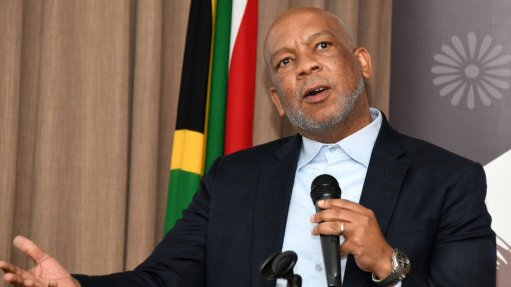ssLNG plants available locally
Designers and suppliers of liquified natural gas (LNG) equipment PolaireTech’s modularised small-scale plants for the liquefaction of natural gas to produce LNG are now available in South Africa.
Commercial deployment of small-scale LNG (ssLNG) plants is driven by the need for cheaper alternatives as compared to crude oil derived fuels. The use of LNG as a replacement fuel presents an opportunity for ssLNG plants.
According to PolaireTech CEO Freek van Heerden, the plants employ a patented zero-refrigerant technology which reduces equipment count and consequently capital cost.
Studies have shown that Matola, Richards Bay, Coega, and other ports in South Africa are possible locations for LNG import terminals. These terminals and the logistics of supplying the LNG require very large import volumes to make these facilities viable, irrespective of whether these facilities are land based or floating storage and regasification units (FSRUs).
At the moment, the only LNG terminal that appears to be moving ahead is the Matola terminal. “It is unclear whether further LNG terminals can be justified, especially considering the rapid gain in momentum of renewable energy,” explains Van Heerden.
Inland Gas Resources
Industrial expansion has been curtailed by the limited gas supply. However, various gas resources exist inland in Southern Africa that can potentially supply all of the region's gas needs into the future, providing labour and reducing foreign exchange demands.
Van Heerden estimates that these gas resources can provide gas to the required provinces cheaper than what would be possible by importing LNG. Substantial gasfields are present in Mpumalanga, Limpopo, Waterberg, and Central Botswana.
The Virginia gasfield in the Free State is currently under development by helium and domestic natural gas producer Renergen which should begin producing LNG by year-end. “The first locally produced LNG will spearhead the development of the local LNG market in specific niche applications,” claims Van Heerden.
Whereas, Botswana is finalising power purchase agreements for their coalbed methane in order to commence power production, he adds.
Commercialising a gasfield is a costly exercise when one considers the exploration work and the need for flowing gas wells to prove the productivity of the field before financing can be secured.
Gas production can be sustainably ramped up whilst the market is being developed. A way to gain this relatively small volume of gas from wellfield development to market is to liquefy the gas, thus enabling it to be cost-effectively transported to customers.
Van Heerden states that the above-mentioned Southern African gasfields are generally inland and much closer to the final customers, so delivery costs are lower than transporting imported LNG from the coast to Gauteng or Botswana.
LNG Technology
In the past, the focus on optimising LNG plants was on reducing the liquefaction cost through economies of scale. This resulted in single-train LNG plant capacities of up to seven-million tons a year, costing multibillion dollars to erect.
Such plants are not suitable for smaller inland gasfields. Over the last five years, several companies have realised that opportunities exist for ssLNG, ranging from 5 000 t/y to 250 000 t/y.
However, it is not possible to scale down the very large plant designs and technologies to these required low capacities, outlines Van Heerden.
Several companies are now offering innovative ssLNG plants that can compete in smaller niche applications. These ssLNG plants face challenging economics given their small scale. Special emphasis must be placed on the development of a competitive offering with the lowest life cycle cost.
Van Heerden explains that achieving the lowest life cycle cost requires a process configuration that strikes a competitive balance between capital and operating cost, and a project development and implementation approach that benefits from a lean, standardised modular design.
He adds that ssLNG plants employ an optimised system of expanders to provide the necessary cryogenic refrigeration using nitrogen or mixed refrigerants in a closed loop. PolaireTech’s zero-refrigerant technology uses methane in the incoming natural gas feed as a refrigerant in an open loop cycle. Owing to higher heat capacity of the methane, power consumption per ton of LNG is typically reduced by around 25% as compared to nitrogen loop systems.
Comments
Press Office
Announcements
What's On
Subscribe to improve your user experience...
Option 1 (equivalent of R125 a month):
Receive a weekly copy of Creamer Media's Engineering News & Mining Weekly magazine
(print copy for those in South Africa and e-magazine for those outside of South Africa)
Receive daily email newsletters
Access to full search results
Access archive of magazine back copies
Access to Projects in Progress
Access to ONE Research Report of your choice in PDF format
Option 2 (equivalent of R375 a month):
All benefits from Option 1
PLUS
Access to Creamer Media's Research Channel Africa for ALL Research Reports, in PDF format, on various industrial and mining sectors
including Electricity; Water; Energy Transition; Hydrogen; Roads, Rail and Ports; Coal; Gold; Platinum; Battery Metals; etc.
Already a subscriber?
Forgotten your password?
Receive weekly copy of Creamer Media's Engineering News & Mining Weekly magazine (print copy for those in South Africa and e-magazine for those outside of South Africa)
➕
Recieve daily email newsletters
➕
Access to full search results
➕
Access archive of magazine back copies
➕
Access to Projects in Progress
➕
Access to ONE Research Report of your choice in PDF format
RESEARCH CHANNEL AFRICA
R4500 (equivalent of R375 a month)
SUBSCRIBEAll benefits from Option 1
➕
Access to Creamer Media's Research Channel Africa for ALL Research Reports on various industrial and mining sectors, in PDF format, including on:
Electricity
➕
Water
➕
Energy Transition
➕
Hydrogen
➕
Roads, Rail and Ports
➕
Coal
➕
Gold
➕
Platinum
➕
Battery Metals
➕
etc.
Receive all benefits from Option 1 or Option 2 delivered to numerous people at your company
➕
Multiple User names and Passwords for simultaneous log-ins
➕
Intranet integration access to all in your organisation





















